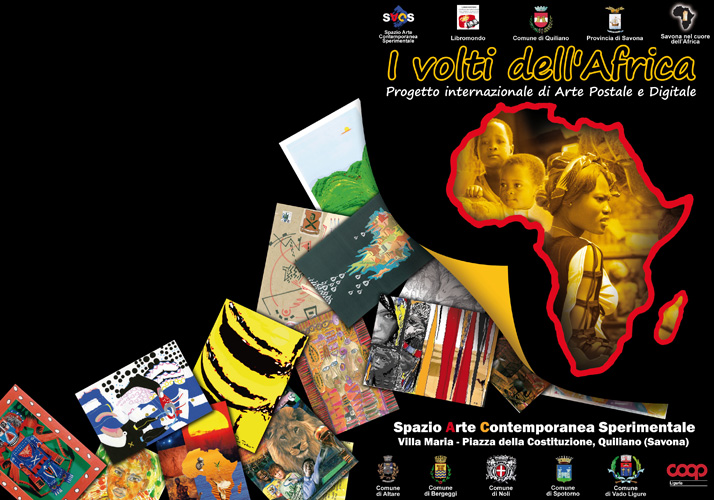 |
|
|---|---|
Video Digital art |
DOWNLOAD: Catalogue I volti dell'Africa.pdf - Brochure - Poster |
IT |
EN |
|---|
 |
 |
|---|---|
The faces of Africa |
|
 |
|
|---|---|
Video Digital art |
DOWNLOAD: Catalogue I volti dell'Africa.pdf - Brochure - Poster |
When I was young I maintained pen friend correspondence with a dear friend of mine from
Bergamo. I remember that once, instead of answering her on a sheet of stationery, I sent only
her the envelope on which I had densely written and drawn. I don’t know if it dealt with a happy
intuition, I know that my creative attempt was not appreciated by her mother who invited me,
her daughter informed me, not to repeat the performance, suppressing at birth my mail-artistic
aspirations.
This explains that at the root of mail art there exists an innate impulse to infringe, to overcome
convention. The spontaneous instinct, to take shape as postal art, does however need channeling
in a linked sequence of actions, from the inception/creation of the message from the
sender, to the dynamic element of its trip, to the recipient.
Mail art is stabilized along a space/time dimension that foresees a duration determined by the
gesture of the sending the art, understood as a liberating act, a bridge thrown by the sender
toward the user, faceless in the object of his/ own expressiveness and therefore donated as
a gift free from the mechanisms of the market. The artistic product therefore realizes itself
outside the wishes of the artist that is the motor of the process itself, becoming co-author of
his own work that will end up far away from him, eventually being accepted by the receiver.
Freedom from money, liberty and sharing are fundamental characteristics of this movement
that, as often noticed, fi nds its presuppositions in the nineteenth century avant-garde, from
futurism to dada, up to its offi cial birth.
With this in mind, it is easy to wonder if it would be possible to reconcile the libertarian spirit
of mail art with a theme, such as that proposed by the contest, though it is certainly noble.
The exceptional number of the submissions that S.A.C.S. received from all parts of the planet,
the wealth of the proposed solutions and the diversity of the participants attest to the validity
of the initiative and the interest aroused by the theme.
The Commune of Quiliano, after all, has for some time chosen the mail art theme, aware of
the vitality of a movement that by now has reached the mainstream - considered a normal
artistic tide. Because the mail art cannot be bound to a poetic code, it represents a means
to communicate ideas, intentions, emotions, and dynamic support through which to transmit
all kinds of artistic contents. Therefore it is always prone to future developments, tied up for
instance to linguistic contamination from other places, such as the internet. Mail art nourishes
itself through a invisible net of contacts on a planetary level, radiates itself outward in
a horizontal sense, it is equal, it doesn’t know hierarchy. It founds itself upon the democratic
participation of affi rmed artists, dilettantes, debutantes, perfect strangers, according to characteristics
common to the world of internet, with which it shares its presuppositions, even in
the substantial distance of the process.
Departing from all presuppositions the project’s theme, “The faces of Africa”, has been interpreted
through the mail metalanguage and, even though in smaller proportions, digital art,
using a different lexicon: visual poetry, fi guration, abstraction, concrete art, conceptual games,
simple expression, collage, photo. This was a group effort, the intention to be there and to
communicate a proper thought and to share an attention.
The exhibit of Quiliano promotes an operation of great humanitarian content, that works well
with the spirit of mail art, nevertheless, I like to imagine that only through the postal art can
we make an inverse operation in which Africa is the sender and we the recipient, done not for
Africa, but with Africa, who is the last to be able to choose the message to communicate with
because it is not us who look to Africa separately but we look as one.